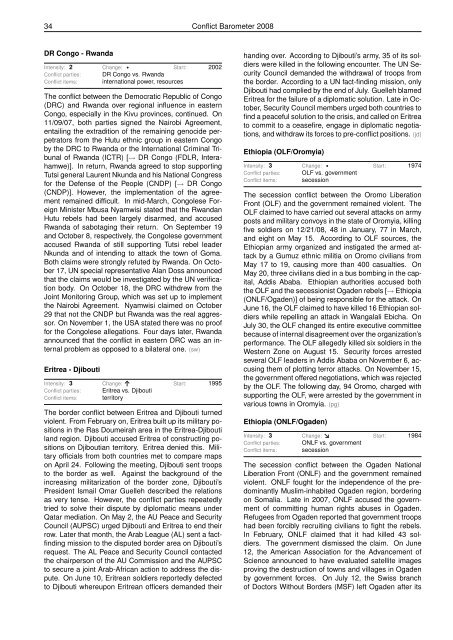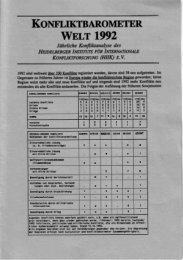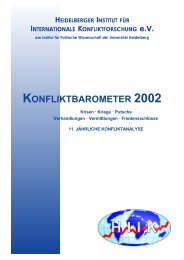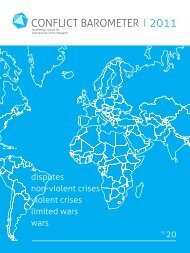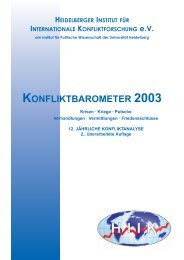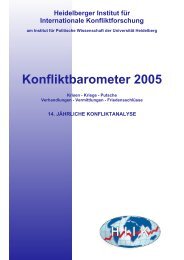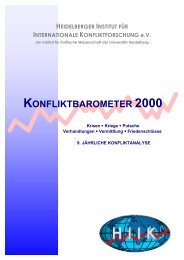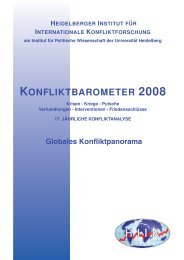CONFLICT BAROMETER 2008
CONFLICT BAROMETER 2008
CONFLICT BAROMETER 2008
You also want an ePaper? Increase the reach of your titles
YUMPU automatically turns print PDFs into web optimized ePapers that Google loves.
34 Conflict Barometer <strong>2008</strong><br />
DR Congo - Rwanda<br />
Intensity: 2 Change: Start: 2002<br />
Conflict parties: DR Congo vs. Rwanda<br />
Conflict items: international power, resources<br />
The conflict between the Democratic Republic of Congo<br />
(DRC) and Rwanda over regional influence in eastern<br />
Congo, especially in the Kivu provinces, continued. On<br />
11/09/07, both parties signed the Nairobi Agreement,<br />
entailing the extradition of the remaining genocide perpetrators<br />
from the Hutu ethnic group in eastern Congo<br />
by the DRC to Rwanda or the International Criminal Tribunal<br />
of Rwanda (ICTR) [→ DR Congo (FDLR, Interahamwe)].<br />
In return, Rwanda agreed to stop supporting<br />
Tutsi general Laurent Nkunda and his National Congress<br />
for the Defense of the People (CNDP) [→ DR Congo<br />
(CNDP)]. However, the implementation of the agreement<br />
remained difficult. In mid-March, Congolese Foreign<br />
Minister Mbusa Nyamwisi stated that the Rwandan<br />
Hutu rebels had been largely disarmed, and accused<br />
Rwanda of sabotaging their return. On September 19<br />
and October 8, respectively, the Congolese government<br />
accused Rwanda of still supporting Tutsi rebel leader<br />
Nkunda and of intending to attack the town of Goma.<br />
Both claims were strongly refuted by Rwanda. On October<br />
17, UN special representative Alan Doss announced<br />
that the claims would be investigated by the UN verification<br />
body. On October 18, the DRC withdrew from the<br />
Joint Monitoring Group, which was set up to implement<br />
the Nairobi Agreement. Nyamwisi claimed on October<br />
29 that not the CNDP but Rwanda was the real aggressor.<br />
On November 1, the USA stated there was no proof<br />
for the Congolese allegations. Four days later, Rwanda<br />
announced that the conflict in eastern DRC was an internal<br />
problem as opposed to a bilateral one. (sw)<br />
Eritrea - Djibouti<br />
Intensity: 3 Change: Start: 1995<br />
Conflict parties: Eritrea vs. Djibouti<br />
Conflict items: territory<br />
The border conflict between Eritrea and Djibouti turned<br />
violent. From February on, Eritrea built up its military positions<br />
in the Ras Doumeirah area in the Eritrea-Djibouti<br />
land region. Djibouti accused Eritrea of constructing positions<br />
on Djiboutian territory. Eritrea denied this. Military<br />
officials from both countries met to compare maps<br />
on April 24. Following the meeting, Djibouti sent troops<br />
to the border as well. Against the background of the<br />
increasing militarization of the border zone, Djibouti’s<br />
President Ismail Omar Guelleh described the relations<br />
as very tense. However, the conflict parties repeatedly<br />
tried to solve their dispute by diplomatic means under<br />
Qatar mediation. On May 2, the AU Peace and Security<br />
Council (AUPSC) urged Djibouti and Eritrea to end their<br />
row. Later that month, the Arab League (AL) sent a factfinding<br />
mission to the disputed border area on Djibouti’s<br />
request. The AL Peace and Security Council contacted<br />
the chairperson of the AU Commission and the AUPSC<br />
to secure a joint Arab-African action to address the dispute.<br />
On June 10, Eritrean soldiers reportedly defected<br />
to Djibouti whereupon Eritrean officers demanded their<br />
handing over. According to Djibouti’s army, 35 of its soldiers<br />
were killed in the following encounter. The UN Security<br />
Council demanded the withdrawal of troops from<br />
the border. According to a UN fact-finding mission, only<br />
Djibouti had complied by the end of July. Guelleh blamed<br />
Eritrea for the failure of a diplomatic solution. Late in October,<br />
Security Council members urged both countries to<br />
find a peaceful solution to the crisis, and called on Eritrea<br />
to commit to a ceasefire, engage in diplomatic negotiations,<br />
and withdraw its forces to pre-conflict positions. (jd)<br />
Ethiopia (OLF/Oromyia)<br />
Intensity: 3 Change: Start: 1974<br />
Conflict parties: OLF vs. government<br />
Conflict items: secession<br />
The secession conflict between the Oromo Liberation<br />
Front (OLF) and the government remained violent. The<br />
OLF claimed to have carried out several attacks on army<br />
posts and military convoys in the state of Oromyia, killing<br />
five soldiers on 12/21/08, 48 in January, 77 in March,<br />
and eight on May 15. According to OLF sources, the<br />
Ethiopian army organized and instigated the armed attack<br />
by a Gumuz ethnic militia on Oromo civilians from<br />
May 17 to 19, causing more than 400 casualties. On<br />
May 20, three civilians died in a bus bombing in the capital,<br />
Addis Ababa. Ethiopian authorities accused both<br />
the OLF and the secessionist Ogaden rebels [→ Ethiopia<br />
(ONLF/Ogaden)] of being responsible for the attack. On<br />
June 16, the OLF claimed to have killed 16 Ethiopian soldiers<br />
while repelling an attack in Wangalali Ebicha. On<br />
July 30, the OLF changed its entire executive committee<br />
because of internal disagreement over the organization’s<br />
performance. The OLF allegedly killed six soldiers in the<br />
Western Zone on August 15. Security forces arrested<br />
several OLF leaders in Addis Ababa on November 6, accusing<br />
them of plotting terror attacks. On November 15,<br />
the government offered negotiations, which was rejected<br />
by the OLF. The following day, 94 Oromo, charged with<br />
supporting the OLF, were arrested by the government in<br />
various towns in Oromyia. (pg)<br />
Ethiopia (ONLF/Ogaden)<br />
Intensity: 3 Change: Start: 1984<br />
Conflict parties: ONLF vs. government<br />
Conflict items: secession<br />
The secession conflict between the Ogaden National<br />
Liberation Front (ONLF) and the government remained<br />
violent. ONLF fought for the independence of the predominantly<br />
Muslim-inhabited Ogaden region, bordering<br />
on Somalia. Late in 2007, ONLF accused the government<br />
of committing human rights abuses in Ogaden.<br />
Refugees from Ogaden reported that government troops<br />
had been forcibly recruiting civilians to fight the rebels.<br />
In February, ONLF claimed that it had killed 43 soldiers.<br />
The government dismissed the claim. On June<br />
12, the American Association for the Advancement of<br />
Science announced to have evaluated satellite images<br />
proving the destruction of towns and villages in Ogaden<br />
by government forces. On July 12, the Swiss branch<br />
of Doctors Without Borders (MSF) left Ogaden after its


